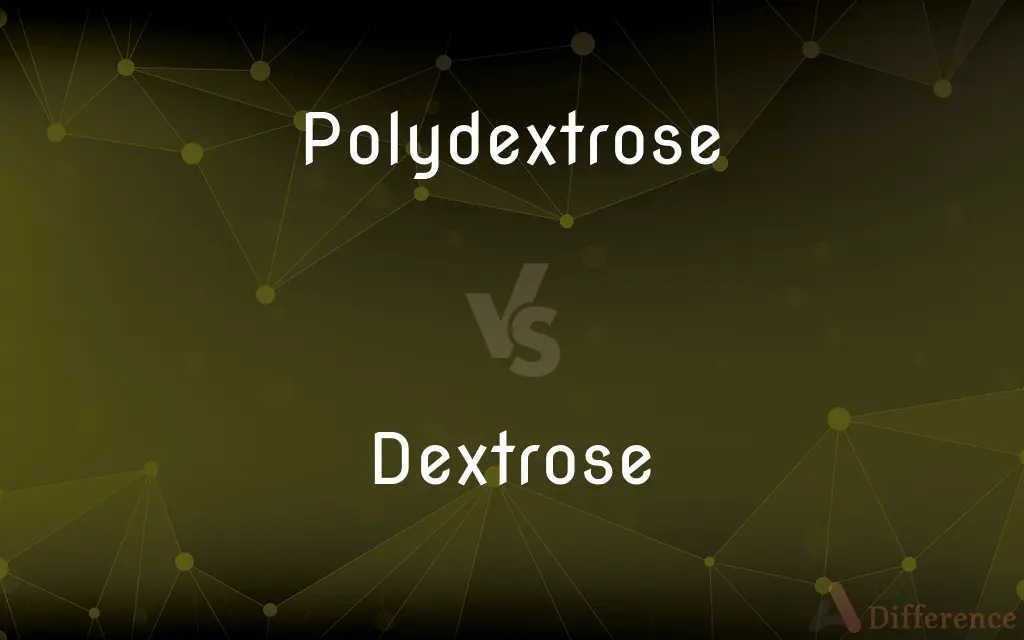Polydextrose vs. Dextrose — What's the Difference?
By Maham Liaqat & Urooj Arif — Updated on April 4, 2024
Polydextrose is a synthetic polymer used as a fiber supplement and food additive, offering little sweetness, whereas dextrose, a form of glucose, is a natural sugar providing energy and sweetness.

Difference Between Polydextrose and Dextrose
Table of Contents
ADVERTISEMENT
Key Differences
Polydextrose and dextrose are both carbohydrates, but they serve different purposes in food and nutrition. Polydextrose is a synthetic polymer of glucose, developed as a low-calorie, soluble fiber to enhance food texture and increase fiber content without adding significant sweetness. It's often used in processed foods to replace sugar or fat while maintaining a desirable texture and mouthfeel. On the other hand, dextrose is a natural form of glucose, derived from starch. It's commonly used as a sweetener in foods and beverages, and as an energy source in sports drinks and supplements due to its quick absorption by the body.
Polydextrose is not digested in the upper gastrointestinal tract, so it contributes fewer calories (about 1 kcal/gram) compared to dextrose, which provides 4 kcal/gram as it is fully absorbed and utilized by the body. This makes polydextrose a popular ingredient in low-calorie and diet foods, whereas dextrose is favored for energy provision in sports nutrition.
While polydextrose acts as a prebiotic, promoting digestive health by supporting the growth of beneficial bacteria in the colon, dextrose does not have significant prebiotic effects. Polydextrose's role in gut health is an added benefit over its use as a texturizer and fiber source in foods.
In terms of taste, polydextrose has a minimal impact on sweetness, making it suitable for foods where excessive sweetness is not desired. Dextrose, however, is known for its sweet taste and is often used to enhance the flavor of food products.
Polydextrose's versatility extends to its use as a bulking agent in a wide range of products, from baked goods to beverages, without significantly altering the taste profile. Dextrose, with its sweet flavor, is limited to applications where sweetness is a benefit, including candies, baked goods, and sports drinks.
ADVERTISEMENT
Comparison Chart
Nature
Synthetic polymer of glucose
Natural form of glucose
Calories
Low (about 1 kcal/gram)
Higher (4 kcal/gram)
Digestibility
Not digested in the upper GI tract
Fully absorbed and utilized
Prebiotic Effects
Acts as a prebiotic
Lacks significant prebiotic effects
Taste Contribution
Minimal sweetness, used to improve texture
Sweet, used as a sweetener
Primary Use
Fiber supplement, food additive
Sweetener, energy source
Applications
Low-calorie and diet foods
Sweet foods, sports nutrition
Compare with Definitions
Polydextrose
A synthetic polymer used primarily as a soluble fiber additive in various food products.
Polydextrose is often added to cookies to increase their fiber content without affecting sweetness.
Dextrose
Has a sweet taste, making it ideal for enhancing the flavor of food and beverages.
Dextrose is used in baking to sweeten breads and pastries.
Polydextrose
Provides roughly 1 kcal/gram, making it suitable for low-calorie diets.
Polydextrose is used in diet beverages to enhance mouthfeel with minimal calorie addition.
Dextrose
Provides 4 kcal/gram, utilized by the body for energy.
Consuming dextrose after workouts can help replenish glycogen stores quickly.
Polydextrose
It is not fully digested, hence contributing less to caloric intake.
Polydextrose passes through the stomach undigested, aiding in bowel movement.
Dextrose
Easily absorbed and utilized by the body for energy.
Dextrose is often given intravenously in hospitals to patients needing quick energy.
Polydextrose
Used as a bulking agent and to improve the texture of low-fat or low-sugar foods.
Polydextrose is added to ice cream to maintain creaminess with reduced fat.
Dextrose
Used in foods and beverages where sweetness is desired, including confectioneries and sports nutrition products.
Dextrose powder is popular among athletes for pre-workout energy.
Polydextrose
Supports healthy bacteria in the gut, promoting digestive health.
Consuming foods with polydextrose can improve your gut flora over time.
Dextrose
A simple sugar derived from starch, commonly used as a sweetener and energy source.
Dextrose is a primary ingredient in many sports drinks for quick energy.
Polydextrose
Polydextrose is a synthetic polymer of glucose. It is a food ingredient classified as soluble fiber by the US FDA as well as Health Canada, as of April 2013.
Dextrose
The dextrorotatory form of glucose (and the predominant naturally occurring form).
Polydextrose
A multipurpose food ingredient synthesized from dextrose and classified as soluble fibre.
Dextrose
The dextrorotatory form of glucose, C6H12O6·H2O, the naturally occurring form of glucose found in all organisms. Also called dextroglucose.
Dextrose
The naturally-occurring dextrorotatory form of glucose monosaccharide molecule.
Dextrose
A sirupy, or white crystalline, variety of sugar, C6H12O6 (so called from turning the plane of polarization to the right), occurring in many ripe fruits, and also called glucose. Dextrose and levulose are obtained by the inversion of cane sugar or sucrose, and hence the mixture is called called invert sugar. Dextrose is chiefly obtained by the action of heat and acids on starch, and hence called also starch sugar. It is also formed from starchy food by the action of the amylolytic ferments of saliva and pancreatic juice.
Dextrose
An isomer of glucose that is found in honey and sweet fruits
Common Curiosities
What is polydextrose?
Polydextrose is a synthetic soluble fiber used as a food additive to increase dietary fiber content and improve texture without adding significant sweetness.
Is dextrose suitable for diabetics?
Dextrose can cause blood sugar spikes; therefore, its consumption should be carefully managed by diabetics.
Can polydextrose be used as a sweetener?
While polydextrose can slightly sweeten products, its primary use is not as a sweetener but as a fiber supplement and texture enhancer.
What are common applications of polydextrose?
It is used in low-calorie, low-fat, and low-sugar foods to improve texture and fiber content.
What is dextrose?
Dextrose is a natural form of glucose used as a sweetener and energy source in foods and beverages.
How are polydextrose and dextrose different in terms of caloric content?
Polydextrose has a lower caloric content (about 1 kcal/gram) compared to dextrose (4 kcal/gram).
Can consuming polydextrose aid in weight management?
Yes, due to its low caloric content and fiber content, it can help in weight management.
Is polydextrose safe for everyone?
Generally, it is considered safe, but some people may experience digestive discomfort.
Do both polydextrose and dextrose have prebiotic effects?
Polydextrose acts as a prebiotic, whereas dextrose does not have significant prebiotic effects.
Where is dextrose commonly found?
Dextrose is found in sweets, sports drinks, and as a carbohydrate source in medical settings.
Why is dextrose used in sports nutrition?
It provides quick energy to muscles during and after intense workouts.
Share Your Discovery

Previous Comparison
Pascal vs. Torr
Next Comparison
Gnat vs. MosquitoAuthor Spotlight
Written by
Maham LiaqatCo-written by
Urooj ArifUrooj is a skilled content writer at Ask Difference, known for her exceptional ability to simplify complex topics into engaging and informative content. With a passion for research and a flair for clear, concise writing, she consistently delivers articles that resonate with our diverse audience.














































